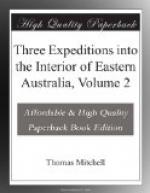THE PARTY EXTRICATED WITH DIFFICULTY FROM THE MUD.
August 8.
It was in vain that I reconnoitred the environs of the hill of mud for some portion of surface harder than the rest; and we could only extricate ourselves by floundering through it. Patches of clay occurred but they led only to places where the surface under the pressure of the cattle was immediately converted into white and liquid mud. It was necessary to take the loads from the carts and carry them by hand half a mile, and then to remove the empty vehicles by the same means. After all this had been accomplished the boat-carriage (a four-wheeled waggon) still remained immovably fixed up to the axle-tree in mud in a situation where the block and tackle used in hoisting out the boats could not be applied. Much time was lost in our attempts to draw it through by joining all the chains we possessed and applying the united strength of all the bullocks; but even this was at length accomplished after the sun had set; the wheels, four inches broad, actually cutting through to the full depth of the spokes. On the eastern side of the hill the ground descended into a ravine where it was grassy and firm enough; and it was a great relief to us all to feel thus at liberty, even by sunset, to start next morning towards the beautiful country which we now knew lay before us.
CHAPTER 3.10.
Cross various rivulets.
Enter the valley of Nangeela.
Native female and child.
Encamp on the Glenelg.
Cross the Wannon.
Rifle range.
Mount Gambier first seen from it.
Sterile moors crossed by the party.
Natives numerous but not accessible.




